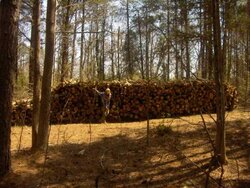Does the moisture evaporate from the end or mostly through the bark? If a tree dies and it doesn’t fall for a year or two it is dry when cut. I just started cutting wood for my wood furnace in November of 2007 to save time I stacked the logs in 8’ lengths and covered the top of the stack. Most of them will not need to be split but after reading on this sight I’m now thinking that this might not be a good idea. Will it take my wood another season to dry out like this or would it be a few more months. BTW, it is various types of wood oak, sweet gum, poplar and maple.
How does wood season?
- Thread starter Bspring
- Start date
-
Active since 1995, Hearth.com is THE place on the internet for free information and advice about wood stoves, pellet stoves and other energy saving equipment.
We strive to provide opinions, articles, discussions and history related to Hearth Products and in a more general sense, energy issues.
We promote the EFFICIENT, RESPONSIBLE, CLEAN and SAFE use of all fuels, whether renewable or fossil.


